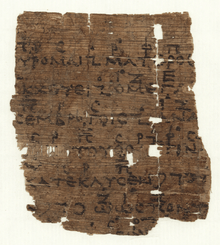Katolophyromai

Katolophyromai is the headword in a musical fragment from the first stasimon of Orestes by Euripides (lines 338-344, Vienna Papyrus G 2315). It means "I cry, lament so much." In 1892, among a number of papyri from Hermopolis, Egypt, in the collection of Archduke Rainer Ferdinand of Austria, a fragment was discovered and published[1] by the papyrologist Karl Wessely, containing a mutilated passage with musical notation.[2] Although the Papyrus is from the 3rd century B.C, the music was probably composed by Euripides himself, around 408 BC.
Since then, it has been the subject of numerous studies. Its text is:
κατολοφύρομαι, κατολοφύρομαι
ματέρος αἷμα σᾶς, ὅ σ’ ἀναβακχεύει,
ὁ μέγας ὄλβος οὐ μόνιμος ἐν βροτοῖς,
ἀνὰ δὲ λαῖφος ὥς τις ἀκάτου θοᾶς τινάξας δαίμων
κατέκλυσεν δεινῶν πόνων ὡς πόντου
λάβροις ὀλεθρίοισιν ἐν κύμασιν
- [I cry, I cry, your mother’s blood that drives you mad, great happiness in mortals never lasting, but like a sail of a swift ship, which a god shook up and plunged it with terrible troubles into the greedy and deadly waves of sea.]
The rhythm of the song is catalectic trochaic tetrameter and the tónos or trópos is Lydian. The preserved vocal notes coincide with the Ancient Doric or Phrygian harmonia transmitted by Aristides Quintilianus (On music, I, 18 and II, 80), the Damon harmoniai, in enharmonic genus, which was usual in tragedy of 5th century BC.
The arrangement of the fragmentary text differs from the traditional editions, in which the lines begin with ματέρος αἷμα (mother’s blood) and κατολοφύρομαι appears after βροτοῖς (mortals). Unlike other fragments, however, the text and musical notations are quite well preserved.
Whether this fragment represents the original music Euripides composed in 408 BC is an open question, given also the absence of 5th century BC musical inscriptions. Nevertheless, there is some evidence in favour of the authenticity. Psellus and Plutarch credit Euripides and Agathon with the introduction of chromatic genus and the fragment accords with it but also with observations of Dionysius of Halicarnassus and Aristophanes about the complexity of Euripidean style, which appear in the source: alteration of textual rhythm, reduplication of syllables and chromatic or disjunct musical lines. If the Hellenistic and Roman era musicians and musicologists imitated and reproduced the Classical works the same way librarians, grammarians, Atticists did for literature, this would be another argument or point of further discussion.
There is a recent reconstruction of the musical fragment, from the preserved vocal notes.[3] It is made according to musical and musicological criteria and from the perspective of the Ancient Greek musical theory. This work explains the reasons for choosing each of the notes to fill out the papyrus gaps. Although the conserved vocal notes could belong to both Doric and Phrygian scale used in the time of Euripides, the musical sense seems to fit better with Doric harmony. We know these old harmoniaii by Aristides Quintilianus, who says that those scales belong to enharmonic genus. Reconstruction is accompanied by a sound recording, made according to enharmonic tuning from Archytas, sung by an unprofessional choir, as was frequent in classic tragedy choir. The video, in addition to Greek text and translation into Spanish, presents the preserved and rebuilt notes, as well as its transcription to our musical notation.
References
- ↑ Mitteilungen aus der Sammlung der Papyrus Erzherzog Rainer vol. 5 part 3
- ↑ Thomas J. Mathiesen (1999) places it about 125 years after the death of Euripides. Cambridge University Press (1928) in the Augustan age.
- ↑ Luis Colomer Blasco, El fragmento musical de Orestes de Eurípides (2016) (Spanish).
Further reading
- Apollo’s lyre: Greek music and music theory in antiquity and the Middle Ages By Thomas J. Mathiesen Pages 116-124 (1999)
- The Orestes of Euripides Excursus B, the Musical Fragment, Pages 203-204 Cambridge University Press (1928).
External links
- Performance by Daemonia Nymphe, by Petros Tabouris
- Translation of the fragment by Dr. Norman Prinsky
- The whole stasimon, lines 316 – 347 in English and Greek from Perseus Project